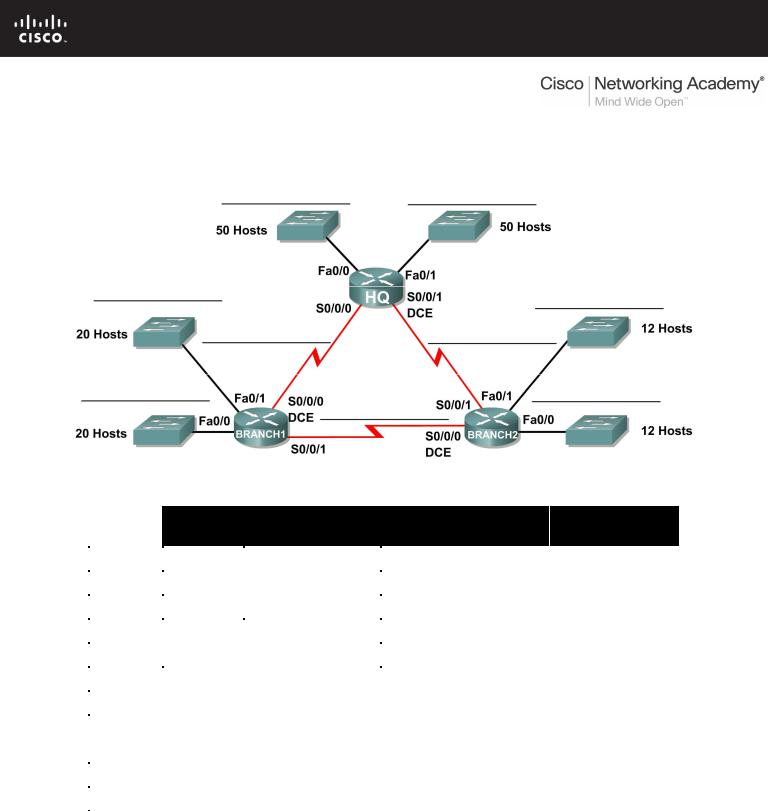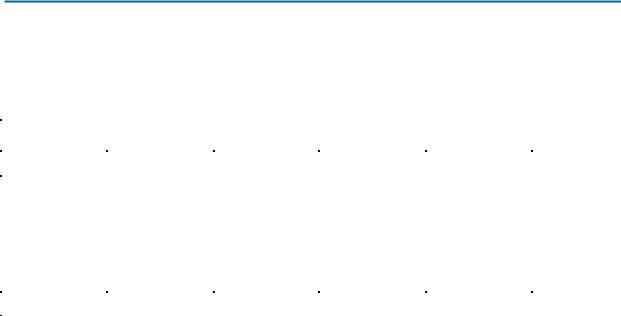
- •Lab 1.5.1: Cabling a Network and Basic Router Configuration
- •Lab 1.5.2: Basic Router Configuration
- •Lab 1.5.3: Challenge Router Configuration
- •1.6.1: Packet Tracer Skills Integration Challenge Activity
- •Lab 2.8.1: Basic Static Route Configuration
- •Lab 2.8.2: Challenge Static Route Configuration
- •Lab 2.8.3: Troubleshooting Static Routes
- •2.9.1: Packet Tracer Skills Integration Challenge Activity
- •Activity 3.5.2: Subnetting Scenario 1
- •Activity 3.5.3: Subnetting Scenario 2
- •Activity 3.5.4: Subnetting Scenario 3
- •3.6.1: Packet Tracer Skills Integration Challenge Activity
- •Lab 4.6.1: Routing Table Interpretation Lab
- •4.7.1: Packet Tracer Skills Integration Challenge Activity
- •Lab 5.6.1: Basic RIP Configuration
- •Lab 5.6.2: Challenge RIP Configuration
- •Lab 5.6.3: RIP Troubleshooting
- •5.7.1: Packet Tracer Skills Integration Challenge Activity
- •Activity 6.4.1: Basic VLSM Calculation and Addressing Design
- •Activity 6.4.2: Challenge VLSM Calculation and Addressing Design
- •Activity 6.4.3: Troubleshooting a VLSM Addressing Design
- •Activity 6.4.4: Basic Route Summarization
- •Activity 6.4.5: Challenge Route Summarization
- •Activity 6.4.6: Troubleshooting Route Summarization
- •6.5.1: Packet Tracer Skills Integration Challenge Activity
- •Lab 7.5.1: RIPv2 Basic Configuration Lab
- •Lab 7.5.2: RIPv2 Challenge Configuration Lab
- •Lab 7.5.3: RIPv2 Troubleshooting Lab
- •7.6.1: Packet Tracer Skills Integration Challenge Activity
- •Lab 8.4.1: Investigating the Routing Table Lookup Process
- •Lab 8.4.2: Show IP Route Challenge Lab
- •8.5.1: Packet Tracer Skills Integration Challenge Activity
- •Lab 9.6.1: Basic EIGRP Configuration Lab
- •Lab 9.6.2: Challenge EIGRP Configuration Lab
- •Lab 9.6.3: EIGRP Troubleshooting Lab
- •9.7.1: Packet Tracer Skills Integration Challenge Activity
- •10.3.1: Packet Tracer Skills Integration Challenge Activity
- •Lab 11.6.1: Basic OSPF Configuration Lab
- •Lab 11.6.2: Challenge OSPF Configuration Lab
- •Lab 11.6.3: OSPF Troubleshooting Lab
- •11.7.1: Packet Tracer Skills Integration Challenge Activity

Activity 6.4.1: Basic VLSM Calculation and Addressing Design
Topology Diagram
Addressing Table
|
Device |
Interface |
IP Address |
Subnet Mask |
Default Gateway |
|
|
|
|
|
|
|
|
Fa0/0 |
|
|
N/A |
|
|
|
|
|
|
|
HQ |
Fa0/1 |
|
|
N/A |
|
|
|
|
|
|
|
S0/0/0 |
|
|
N/A |
|
|
|
|
|
||
|
|
|
|
|
|
|
|
S0/0/1 |
|
|
N/A |
|
|
|
|
|
|
|
|
Fa0/0 |
|
|
N/A |
|
|
|
|
|
|
|
Branch1 |
Fa0/1 |
|
|
N/A |
|
|
|
|
|
|
|
S0/0/0 |
|
|
N/A |
|
|
|
|
|
||
|
|
|
|
|
|
|
|
S0/0/1 |
|
|
N/A |
|
|
|
|
|
|
|
|
Fa0/0 |
|
|
N/A |
|
|
|
|
|
|
|
Branch2 |
Fa0/1 |
|
|
N/A |
|
|
|
|
|
|
|
S0/0/0 |
|
|
N/A |
|
|
|
|
|
||
|
|
|
|
|
|
|
|
S0/0/1 |
|
|
N/A |
|
|
|
|
|
|
All contents are Copyright © 1992–2007 Cisco Systems, Inc. All rights reserved. This document is Cisco Public Information. |
Page 1 of 5 |

CCNA Exploration |
|
Routing Protocols and Concepts: |
|
VLSM and CIDR |
Activity 6.4.1: Basic VLSM Calculation and Addressing Design |
Learning Objectives
Upon completion of this activity, you will be able to:
•Determine the number of subnets needed.
•Determine the number of hosts needed for each subnet
•Design an appropriate addressing scheme using VLSM.
•Assign addresses and subnet mask pairs to device interfaces.
•Examine the use of the available network address space.
Scenario
In this activity, you have been given the network address 192.168.1.0/24 to subnet and provide the IP addressing for the network shown in the Topology Diagram. VLSM will be used so that the addressing requirements can be met using the 192.168.1.0/24 network. The network has the following addressing requirements:
•The HQ LAN1 will require 50 host IP addresses.
•The HQ LAN2 will require 50 host IP addresses.
•The Branch1 LAN1 will require 20 host IP addresses.
•The Branch1 LAN2 will require 20 host IP addresses
•The Branch2 LAN1 will require 12 host IP addresses.
•The Branch2 LAN2 will require 12 host IP addresses.
•The link from HQ to Branch1 will require an IP address for each end of the link.
•The link from HQ to Branch2 will require an IP address for each end of the link.
•The link Branch1 to Branch2 will require an IP address for each end of the link.
Task 1: Examine the Network Requirements.
Examine the network requirements and answer the questions below. Keep in mind that IP addresses will be needed for each of the LAN interfaces.
1.How many subnets are needed? _______
2.What is the maximum number of IP addresses that are needed for a single subnet? _______
3.How many IP addresses are needed for each of the BranchBranch1 LANs? _______
4.How many IP addresses are needed for each of the BranchBranch2 LANs? _______
5.How many IP addresses are needed for each of the WAN links between routers? _______
6.What is the total number of IP addresses that are needed? _______
7.What is the total number of IP addresses that are available in the 192.168.1.0/24 network?
_______
8. Can the network addressing requirements be met using the 192.168.1.0/24 network? _______
Task 2: Design an IP Addressing Scheme
Step 1: Determine the subnet information for the largest network segment or segments.
In this case, the two HQ LANs are the largest subnets.
All contents are Copyright © 1992–2007 Cisco Systems, Inc. All rights reserved. This document is Cisco Public Information. |
Page 2 of 5 |

CCNA Exploration |
|
Routing Protocols and Concepts: |
|
VLSM and CIDR |
Activity 6.4.1: Basic VLSM Calculation and Addressing Design |
1.How many IP addresses are needed for each LAN? _______
2.What is the smallest size subnet that can be used to meet this requirement? _______
3.What is the maximum number of IP addresses that can be assigned in this size subnet? _______
Step 2: Assign subnets to HQ LANs.
Start at the beginning of the 192.168.1.0/24 network.
1.Assign the first available subnet to HQ LAN1.
2.Fill in the chart below with the appropriate information.
HQ LAN1 Subnet
Network |
Decimal |
CIDR Subnet |
First Usable IP |
Last Usable IP |
Broadcast |
Address |
Subnet Mask |
Mask |
Address |
Address |
Address |
|
|
|
|
|
|
3.Assign the next available subnet to HQ LAN2.
4.Fill in the chart below with the appropriate information.
HQ LAN2 Subnet
Network |
Decimal |
CIDR Subnet |
First Usable IP |
Last Usable IP |
Broadcast |
Address |
Subnet Mask |
Mask |
Address |
Address |
Address |
|
|
|
|
|
|
Step 3: Determine the subnet information for the next largest network segment or segments.
In this case, the two Branch1 LANs are the next largest subnets.
1.How many IP addresses are needed for each LAN? _______
2.What is the smallest size subnet that can be used to meet this requirement? _______
3.What is the maximum number of IP addresses that can be assigned in this size subnet? _______
30
Step 4: Assign subnet to BRANCH1 LANs.
Start with the IP address following the HQ LAN subnets.
1.Assign the next subnet to Branch1 LAN1.
2.Fill in the chart below with the appropriate information.
Branch1 LAN1 Subnet
Network |
Decimal |
CIDR Subnet |
First Usable IP |
Last Usable IP |
Broadcast |
Address |
Subnet Mask |
Mask |
Address |
Address |
Address |
|
|
|
|
|
|
3. Assign the next available subnet to Branch1 LAN2.
All contents are Copyright © 1992–2007 Cisco Systems, Inc. All rights reserved. This document is Cisco Public Information. |
Page 3 of 5 |

CCNA Exploration |
|
Routing Protocols and Concepts: |
|
VLSM and CIDR |
Activity 6.4.1: Basic VLSM Calculation and Addressing Design |
4.Fill in the chart below with the appropriate information.
Branch1 LAN2 Subnet
Network |
Decimal |
CIDR Subnet |
First Usable IP |
Last Usable IP |
Broadcast |
Address |
Subnet Mask |
Mask |
Address |
Address |
Address |
|
|
|
|
|
|
Step 5: Determine the subnet information for the next largest network segment or segments.
In this case, the two Branch2 LANs are the next largest subnets.
1.How many IP addresses are needed for each LAN? _______
2.What is the smallest size subnet that can be used to meet this requirement? _______
3.What is the maximum number of IP addresses that can be assigned in this size subnet? _______
Step 6: Assign subnets to BRANCH2 LANs.
Start with the IP address following the Branch1 LAN subnets.
1.Assign the next subnet to the Branch2 LAN1. Fill in the chart below with the appropriate information.
Branch2 LAN1 Subnet
Network |
Decimal |
CIDR Subnet |
First Usable IP |
Last Usable IP |
Broadcast |
Address |
Subnet Mask |
Mask |
Address |
Address |
Address |
|
|
|
|
|
|
2.Assign the next available subnet to Branch2 LAN2.
3.Fill in the chart below with the appropriate information.
Branch2 LAN2 Subnet
Network |
Decimal |
CIDR Subnet |
First Usable IP |
Last Usable IP |
Broadcast |
Address |
Subnet Mask |
Mask |
Address |
Address |
Address |
|
|
|
|
|
|
Step 7: Determine the subnet information for the links between the routers.
1.How many IP addresses are needed for each link? _______
2.What is the smallest size subnet that can be used to meet this requirement? _______
3.What is the maximum number of IP addresses that can be assigned in this size subnet? _______
Step 8: Assign subnets to links.
Start with the IP address following the Branch2 LAN subnets.
1.Assign the next available subnet to the link between the HQ and Branch1 routers.
2.Fill in the chart below with the appropriate information.
Link between HQ and Branch1 Subnet
Network |
Decimal |
CIDR Subnet |
First Usable IP |
Last Usable IP |
Broadcast |
Address |
Subnet Mask |
Mask |
Address |
Address |
Address |
|
|
|
|
|
|
All contents are Copyright © 1992–2007 Cisco Systems, Inc. All rights reserved. This document is Cisco Public Information. |
Page 4 of 5 |

CCNA Exploration |
|
Routing Protocols and Concepts: |
|
VLSM and CIDR |
Activity 6.4.1: Basic VLSM Calculation and Addressing Design |
3.Assign the next available subnet to the link between the HQ and Branch2 routers.
4.Fill in the chart below with the appropriate information.
Link between HQ and Branch2 Subnet
Network |
Decimal |
CIDR Subnet |
First Usable IP |
Last Usable IP |
Broadcast |
Address |
Subnet Mask |
Mask |
Address |
Address |
Address |
|
|
|
|
|
|
5.Assign the next available subnet to the link between the Branch1 and Branch2 routers.
6.Fill in the chart below with the appropriate information.
Link between Branch1 and Branch2 Subnet
Network |
Decimal |
CIDR Subnet |
First Usable IP |
Last Usable IP |
Broadcast |
Address |
Subnet Mask |
Mask |
Address |
Address |
Address |
|
|
|
|
|
|
Task 3: Assign IP Addresses to the Network Devices
Assign the appropriate addresses to the device interfaces. Document the addresses to be used in the Addressing Table provided under the Topology Diagram.
Step 1: Assign addresses to the HQ router.
1.Assign the first valid host address in the HQ LAN 1 subnet to the Fa0/0 LAN interface.
2.Assign the first valid host address in the HQ LAN 2 subnet to the Fao/1 LAN interface.
3.Assign the first valid host address in the link between HQ and Branch1 subnet to the S0/0/0 interface.
4.Assign the first valid host address in the link between HQ and Branch2 subnet to the S0/0/1 interface.
Step 2: Assign addresses to the Branch1 router.
1.Assign the first valid host address in the Branch1 LAN1 subnet to the Fa0/0 LAN interface.
2.Assign the first valid host address in the Branch1 LAN2 subnet to the Fa0/1 LAN interface.
3.Assign the last valid host address on the link between Branch1 and HQ subnet to the S0/0/0 interface
4.Assign the first valid host address on the link between Branch1 and Branch2 subnet to the S0/0/1 interface.
Step 3: Assign addresses to the Branch2 router.
1.Assign the first valid host address in the Branch2 LAN1 subnet to the Fa0/0 LAN interface.
2.Assign the first valid host address in the Branch 2 LAN 2 subnet to the Fa0/1 LAN interface.
3.Assign the last valid host address on the link between HQ and Branch2 subnet to the S0/0/1 interface
4.Assign the last valid host address on the link between Branch1 and Branch2 subnet to the S0/0/0 interface.
All contents are Copyright © 1992–2007 Cisco Systems, Inc. All rights reserved. This document is Cisco Public Information. |
Page 5 of 5 |
